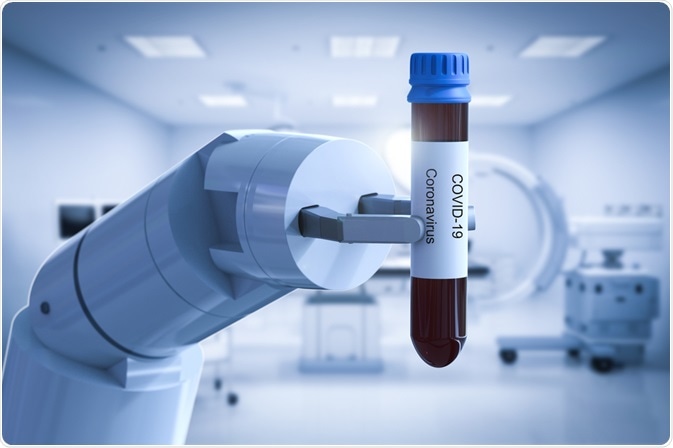First identified in China, 2019, COVID-19 rapidly spread around the world and was eventually declared a pandemic by the World Health Organization (WHO) in May 2020. As of June 2021, the virus has caused the deaths of 3.7 million people worldwide and has infected at least 172.1 million (confirmed cases).

Lab Robot and COVID-19. Image Credit: Phonlamai Photo/Shutterstock.com
While preventative measures have been established and several vaccinations have been approved and rapidly rolled out, the pandemic still presents a major challenge to health organizations worldwide, particularly as new variants continue to emerge.
A need remains for effective systems that prevent the spread of the contagious disease, which new research suggests is primarily transmitted via infected droplets/aerosols in the air that is released as an infected person breathes, talks, coughs, etc. Scientists have discussed the possible role that robots may play in helping to manage the COVID-19 pandemic.
Robots have also been deployed to assist in disinfection tasks, removing people from positions where they may come into contact with the virus. It has also been suggested that robots could assist in delivering medications and food to those hospitalized with COVID-19, again, removing healthcare staff from tasks that bring them into close proximity with the infection. Robots may also be developed to automatically collect information on vital signs, that could help identify those showing signs of COVID-19 infection, acting as a method of early diagnosis, where people could be quarantined quickly, reducing the number of people they expose to the virus.
Finally, robots are being used in laboratories to speed up Covid-19 testing, again identifying those infected faster, reducing the number of people they may spread the virus to. Here, we will discuss in detail this final application.
The multiple possible applications of robots in COVID-19 testing
Robotics are already commonplace in some medical scenarios, such as in laboratory testing. At the beginning of the COVID-19 pandemic, scientists began looking to robotics to establish ways to leverage and develop existing technology to manage the pandemic. Quickly, researchers began exploring how robots could help in the area of testing.
Some teams envisioned the technology being used to cut down on face-to-face testing, where robots would collect and test samples rather than health care professionals to limit the amount of time they spent potentially exposed to the virus. However, the relatively high costs of this hypothetical system along with the increasing availability of at-home testing prevented this avenue from being fully explored as its potential benefits did not outweigh the drawbacks.
On the other hand, the use of robots in a back-end laboratory setting has been a fruitful exploration of the use of robots in managing the COVID-19 pandemic. Scientists have developed laboratory-based robots, giving them the capabilities of conducting sample extraction and amplification.
Such endeavors have integrated laboratory-based robots with already-established software and interfaces, utilizing currently available technology to efficiently establish new testing protocols for Covid-19. Below, we discuss a particularly successful example of this.
Scaling up COVID-19 testing capacity with robots
Researchers at Imperial College, London, successfully repurposed an existing high-throughput robotic platform, built for synthetic biology research, to carry out COVID-19 testing and help NHS diagnostic labs avoid the bottlenecks that they were suffering back in 2020.
The full details of the team’s work were published in September 2020 in the journal Nature Communications. The team hopes that their platform will be adopted more widely by research teams working in other fields.
In a world-first, Biofoundaries, a system that uses robots in synthetic biology research, was adopted by the Imperial team to run COVID-19 testing. The technology has the capacity to process as many as 1,000 samples in just 12 hours. Funding received from the UK Dementia Research Institute allowed a team, led by Professor Paul Freemont, to adapt the technology so that it could effectively test for active cases of SARS-CoV-2 infection.
To achieve this, the team created new software and hardware and developed new testing standards to ensure highly reproducible results. They also applied CRISPR and LAMP technology to the already-existing antigen testing platform to enable the platform to detect SARS-CoV-2 infection.
The technology was rapidly picked up by NHS pathology labs who are currently using it for frontline testing. Already, the system has proven its worth. In just five days following a local outbreak, the system had run 5,000 samples, something that likely would not have been achievable without a robotic system. As a result, it can be suggested that fewer people contracted the virus than would have due to the rapidly available testing.
The team hopes that their technology will also be useful outside of the field of COVID-19 testing, they envision it being adapted to enable low-cost, rapid testing for other infectious diseases such as HIV, Hepatitis, and Influenza.
Sources:
- Covid map: Coronavirus cases, deaths, vaccinations by country. BBC News. Available at: https://www.bbc.co.uk/news/world-51235105
- Cresswell, K., Ramalingam, S. and Sheikh, A., 2020. Can Robots Improve Testing Capacity for SARS-CoV-2?. Journal of Medical Internet Research, 22(8), p.e20169. https://www.ncbi.nlm.nih.gov/pmc/articles/PMC7450371/
- Crone, M., Priestman, M., Ciechonska, M., Jensen, K., Sharp, D., Anand, A., Randell, P., Storch, M. and Freemont, P., 2020. A role for Biofoundries in rapid development and validation of automated SARS-CoV-2 clinical diagnostics. Nature Communications, 11(1). https://www.nature.com/articles/s41467-020-18130-3
Further Reading
Last Updated: Jul 7, 2021